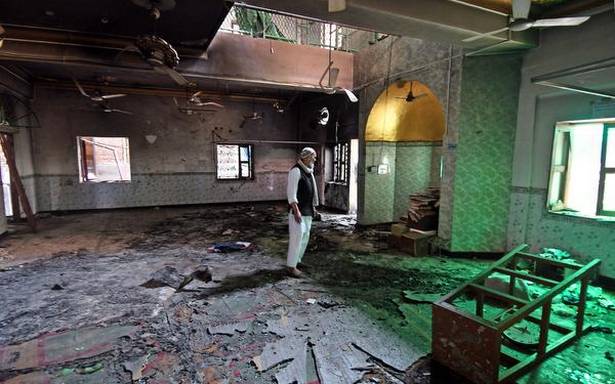On February 27 afternoon, a few days after deadly riots rocked north-east Delhi, the busy marketplace of Maujpur is deserted. On the road lies a shoe and some charred clothes, reminders of the violence three days earlier. A tea shop, singled out and vandalised, is shut. “Ab yeh hain toh shanti hai (now that they are here there is peace),” says the owner, Wasim Khan, pointing to the men in varying shades of khaki and blue who are keeping vigil in the neighbourhood. Apart from the Delhi Police, personnel of the Rapid Action Force march in small batches in what is often referred to as an area domination exercise to secure peace. Khan is grateful that he is alive.
On February 24, an agitation against the Citizenship Amendment Act (CAA) quickly spiralled out of control when both CAA supporters and protesters ran amok in the neighbouring colonies of Maujpur. Jaffrabad, Shiv Vihar, Mustafabad, Chand Bagh, Brijpuri, Babarpur, Karawal Nagar, Khajoori Khas and Yamuna Vihar are all infamous — together these areas have lost 53 people to the violence; 250 are injured.
Delhi violence | Looted, burnt out homes offer little welcome to Shiv Vihar’s riot victims
In the vast, squalid urban sprawl that is north-east Delhi, pockmarked with open drains, Swachh Bharat is a distant dream. The development plank of the re-elected Aam Aadmi Party (AAP) does not resonate here. There are no tarred roads, only galis (streets) with numbers. They are often referred to as ‘20 foota’ and ‘25 foota’, indicating the width of a particular lane. Migrants from the populous States of Uttar Pradesh and Bihar live in these areas that are chock-a-block with houses and shops.
On February 24 and 25, as rioters from the Hindu and Muslim communities, armed with swords, guns, stones, rods and bricks, targeted shops, madrasas, masjids, schools, vehicles, and people, both the Arvind Kejriwal-led AAP government in Delhi and the Narendra Modi-led BJP government in the Centre simply watched.
Khan speaks softly. His lips quiver and his fingers shake as he talks of his shop being vandalised and his refrigerator being emptied out in the dark of the night. “I have no enemies,” he says. His neighbours in the marketplace say Khan will sell his shop soon and move out of the area.
Further ahead is Gonda Chowk where the skeletons of buses and auto-rickshaws lie on the road. Suddenly, there is a huge explosion. A thick plume of smoke goes up in a house behind a departmental store. In moments, the wail of a fire engine pierces the day. The sound is enough for everyone to down the shutters. In a battery-operated auto-rickshaw, a man whispers as he shares with us an incendiary WhatsApp message: “Wait till Friday”.
Friday, February 28, goes off peacefully. The faithful offer their prayers.
In several ways, that terrible week of February was a week of many firsts. For the first time in the history of independent India, a U.S. President’s visit to the country coincided with the worst communal violence in recent times. For the first time in recent memory, schools were targeted and burnt; ambulances were denied access to the grievously injured; and journalists were beaten up. The State and Central governments offered little help to the battered, setting off questions about why there was not even a semblance of control as marauding mobs took over the streets. In Votes and Violence, Steven Wilkinson wrote, “Abundant comparative evidence shows that large-scale ethnic rioting does not take place where a state’s army or police force is ordered to stop it using all means necessary.” From all accounts, for the first 26 hours since the riots began, the police did not do their duty. Instead, they watched as property was destroyed and people were lynched. Sometimes, shockingly, a few even participated in the violence.

Stabbed, burnt, shot
D.M.A. Anwar is supervising all those who walked into Al-Hind Hospital. A week after the riots, a ramp built in the hospital to facilitate the movement of wheelchairs is overflowing with people. People thronged Al-Hind Hospital in Mustafabad soon after the violence broke out. Anwar recalls how over 500 patients, just the first lot, were brought to the multi-storey building on the first two days alone. The number swelled over the next few days. “We have only 15 beds and five staff members. But people kept coming, so we just spread out bedsheets and car

